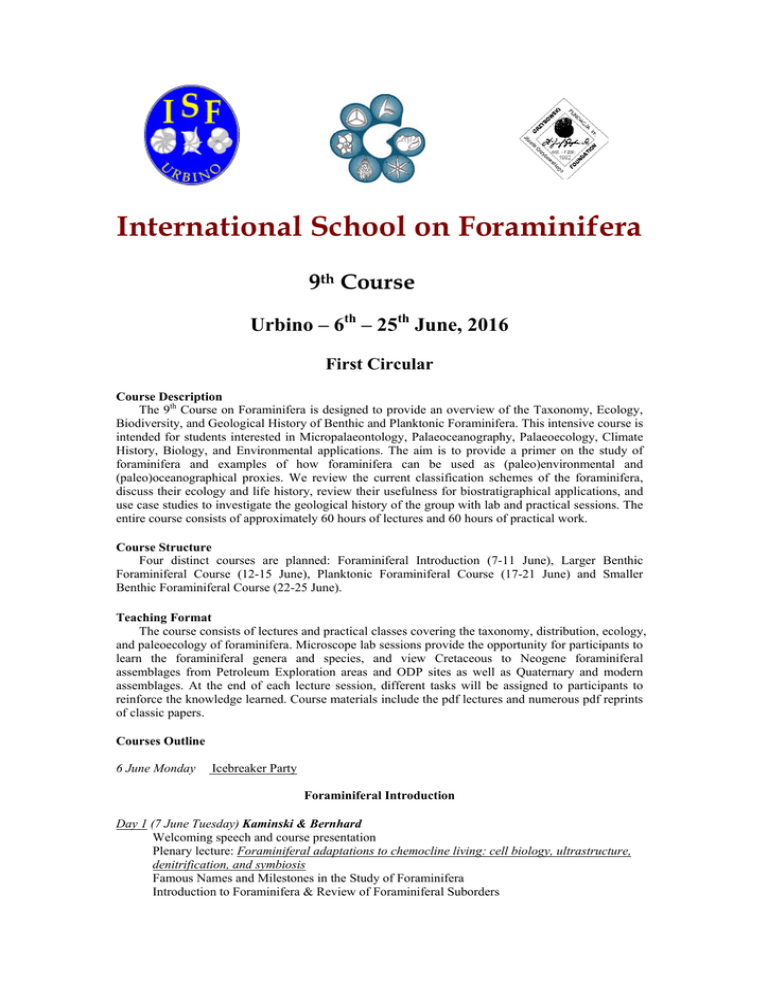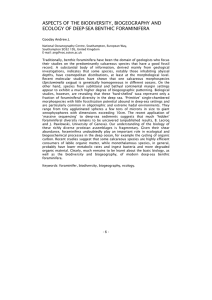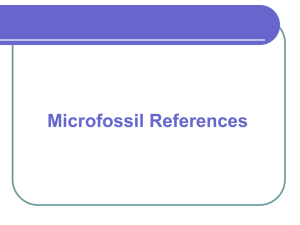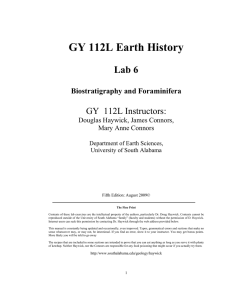the Full Course Details
advertisement

International School on Foraminifera 9th Course Urbino – 6th – 25th June, 2016 First Circular Course Description The 9th Course on Foraminifera is designed to provide an overview of the Taxonomy, Ecology, Biodiversity, and Geological History of Benthic and Planktonic Foraminifera. This intensive course is intended for students interested in Micropalaeontology, Palaeoceanography, Palaeoecology, Climate History, Biology, and Environmental applications. The aim is to provide a primer on the study of foraminifera and examples of how foraminifera can be used as (paleo)environmental and (paleo)oceanographical proxies. We review the current classification schemes of the foraminifera, discuss their ecology and life history, review their usefulness for biostratigraphical applications, and use case studies to investigate the geological history of the group with lab and practical sessions. The entire course consists of approximately 60 hours of lectures and 60 hours of practical work. Course Structure Four distinct courses are planned: Foraminiferal Introduction (7-11 June), Larger Benthic Foraminiferal Course (12-15 June), Planktonic Foraminiferal Course (17-21 June) and Smaller Benthic Foraminiferal Course (22-25 June). Teaching Format The course consists of lectures and practical classes covering the taxonomy, distribution, ecology, and paleoecology of foraminifera. Microscope lab sessions provide the opportunity for participants to learn the foraminiferal genera and species, and view Cretaceous to Neogene foraminiferal assemblages from Petroleum Exploration areas and ODP sites as well as Quaternary and modern assemblages. At the end of each lecture session, different tasks will be assigned to participants to reinforce the knowledge learned. Course materials include the pdf lectures and numerous pdf reprints of classic papers. Courses Outline 6 June Monday Icebreaker Party Foraminiferal Introduction Day 1 (7 June Tuesday) Kaminski & Bernhard Welcoming speech and course presentation Plenary lecture: Foraminiferal adaptations to chemocline living: cell biology, ultrastructure, denitrification, and symbiosis Famous Names and Milestones in the Study of Foraminifera Introduction to Foraminifera & Review of Foraminiferal Suborders Sample Preparation Techniques Lab Task 1: Identification of foraminiferal wall composition, coiling, chamber arrangement, and apertures of benthic foraminifera Lab Task 2: Dividing forms by wall structure, coiling and chamber arrangement Material: Nova Scotia Agglutinated Foraminifera & Mediterranean Sea Day 2 (8 June Wednesday) Kaminski, Cetean & Frontalini Morphology and Classification of Benthic Foraminifera Miliolids, Buliminids and small Rotaliids Collecting modern foraminifera Lab Task 1: Identification of benthic foraminiferal genera: wall composition, coiling, chamber arrangement and shape, and apertures Material: Arabian Gulf and Adriatic Sea Day 3 (9 June Thursday) Kaminski & Cetean Introduction to Planktonic Foraminifera Morphology and Classification of Planktonic Foraminifera Lab task 1: Identification of wall structures, coiling and chamber morphology Material: Sargasso Sea and South Atlantic Day 4 (10 June Friday) Hohenegger & Pawlowski Biology of foraminifera Ecology and taphonomy of foraminifera Lab 1: Statistical analyses for ecological and paleoecological studies Lab 2: Sampling methods for living foraminifera Lab Task 1: Using statistical program packages Day 5 (11 June Saturday) Pawlowski & Sabbatini Taxonomy, distribution and ecology of monothalamous foraminifera Introduction to molecular genetics of Foraminifera Lab 1: Observations of living foraminifera & culturing techniques Lab 2: Samples preparation for DNA extraction Lab Task 1: Recognition and identification of monothalamous foraminifera Larger Benthic Foraminifera Day 6 (12 June Sunday) Hohenegger, Papazzoni & Briguglio Definition, biology and taxonomy of LBF: species concept and classifications Biostratigraphic frameworks: evolutionary tendencies and fossil associations Applications of LBF: Ecology and taphonomic signals Functional morphology of LBF: actuopalaeontological approach Upper Palaeozoic shallow water fauna: the Suborder Fusulinina Lab 1: Hydrodynamics of nummulitids Task 1: Water depth estimation based on LBF Day 7 (13 June Monday) Hughes - Early Carboniferous foraminifera and their use for paleoenvironmental interpretation Lab and Task 1: Asbian foraminiferal identification using thin sections (paleoenvironment study) - Late Permian foraminifera of the Middle East and their biosteering application - Triassic micropalaeontology of her Middle East: age application Lab and Task 2: Triassic foraminiferal identification using photomicrographs (age determination) - Jurassic foraminifera of the Middle East: age, paleoenvironment and implications for cycle definition Lab & Task 3: Jurassic foraminiferal identification using thin sections (age determination) - Jurassic foraminifera of the Middle East (Oxfordian): age and paleoenvironment Lab & Task 4: Jurassic (Oxfordian) foraminiferal identification using photomicrographs: paleoenvironment exercise Late Jurassic hypersalinity events: foraminiferal & associated microfaunal/floral responses Lab & Task 5: Jurassic hypersaline foraminiferal identification using photomicrographs: paleoenvironment study - Cretaceous foraminifera of the Middle East: age, paleoenvironment and implications for cycle definition Lab & Task 6: Cretaceous (Aptian) foraminiferal identification using photomicrographs: age and paleoenvironment exercise - Neogene foraminiferal applications in the Red Sea hypersaline-associated succession Day 8 (14 June Tuesday) Papazzoni & Briguglio The Cenozoic LBF systematic groups Introduction to Palaeogene LBF: biogeography and provinces Early evolution in the Paleocene: agglutinated, porcelanaceous and hyaline The LBF turnover and the Eocene-Oligocene boundary The Eocene biodiversity (I): the genus Alveolina The Eocene biodiversity (II): the genus Nummulites Lab 1: classifications techniques, biometry and thin sections Task 1: Identification of index species in thin section Day 9 (15 June Wednesday) Hohenegger, Papazzoni & Briguglio The nummulite bank: characterization, ecology and biostratinomy The Eocene biodiversity (III): the orthophragminids Oligo-Miocene fauna Distribution of recent LBF Diversity and applications on recent LBF Lab 1: Micro Computed Tomography on recent LBF Task 1: Identification of index species Evening Session: “Foraminiferal Party”. Slide presentations by ISF participants -- five minutes each: -five photos, five PowerPoint slides Day 10 (16 June Thursday) Day-off Planktonic Foraminifera Day 11 (17 June Friday) Kucera & Kaminski Introduction to Planktonic Foraminifera and their Classification Modern Planktonic Foraminifera Taxonomy of modern planktonic foraminifera Structure of cytoplasm, Feeding, Symbionts, Ontogeny Reproductive and seasonal cycles, Depth habitats Origin of Planktonic Foraminifera Biogeography of Planktonic Foraminifera Faunal Provinces, Climatic Zones and Water Masses Lab 1: Recent assemblages - wall texture - shell morphology Task 1: Identification of latitudinal zones based on PF Day 12 (18 June Saturday) Kaminski & Kucera Neogene Planktonic Foraminifera Miocene and Pliocene Planktonic Foraminifera Pleistocene Planktonic Foraminifera Biochronology and Zonal schemes Lab 1: Miocene index species - Pliocene-Pleistocene index species Task 1: Identification of biozones Task 2: Identification of glacial and interglacial assemblages Day 13 (19 June Sunday) Petrizzo Mesozoic Planktonic Foraminifera Biostratigraphy Notes on Paleoceanography Lab 1: Upper Jurassic to Maastrichtian index species Task 1: Morphology of Cretaceous PF Task 2: Identification of biozones Day 14 (20 June Monday) Petrizzo Paleogene Planktonic Foraminifera Biostratigraphy Notes on Paleoceanography Lab 1: Paleogene index species Task 1: Morphology of Paleogene PF Task 2: Identification of biozones Day 15 (21 June Tuesday) Kaminski & Frontalini Morning field excursion to the Gubbio area Cretaceous-Paleogene sequence at Contessa Highway and Contessa Road Paleocene-Eocene Thermal Maximum and other hyperthermals at Contessa Road Oceanic Anoxic Event 2 “Bonarelli” at Contessa Quarry K/Pg boundary at Bottaccione Oceanic Anoxic Event 1a “Selli” at Gorgo a Cerbara Afternoon tourist visit to Gubbio Social Dinner Smaller Benthic Foraminifera Day 16 (22 June Wednesday) Kaminski Morphogroups and functional morphology of smaller benthic foraminifera Ecology and distribution of benthic Foraminifera Lab: Databases, Taxonomy of benthic foraminiferal suborders Task 1: Water depth estimation based on SBF Task 2: Identification of SBF morphogroups Day 17 (23 June Thursday) Kaminski & Frontalini Community Structure, Life History, and Reproduction Oceanographic proxies, benthic foraminiferal microhabitats, and productivity/oxygenation Benthic foraminifera and water mass properties Atlantic and Mediterranean shallow water benthic Foraminifera Lab: Modern smaller benthic foraminifera: Foraminiferal genera and assemblages Task 1: Productivity/oxygen estimation based on SBF Task 2: Environmental Interpretation Day 18 (24 June Friday) Cetean & Alegret Biostratigraphy and Paleoecology of benthic foraminifera The ODP record, Cretaceous/Paleogene boundary, Paleocene-Eocene Thermal Maximum, Eocene hyperthermals and late Eocene Lab: A review of late Cretaceous to Paleogene faunas and index taxa Task 1: Paleodepth estimation based on upper depth limits of SBF Task 2: Paleoproductivity/paleoxygen estimation based on SBF Aperitif Day 19 (25 June Saturday) Kaminski & Foy Cenozoic Paleoceanographic events and SBF Neogene of West Africa, and Gulf of Mexico: The ACEX Arctic Drilling Expedition Lab: The Paleogene record; North Sea, Trinidad, Angola, Carpathians, Gubbio A review of Jurassic to late Cretaceous faunas, Bering Sea Pleistocene faunas Task 1: Flysch type fauna identification – index taxa Task 2: Oxygen minimum zone fauna Rigs and Stuff Wellsite Micropalaeontology Min number of participants: 10 Final deadline May 6th, 2016 Registration fees Early registration (application sent and payment before February 5th, 2016) PhD/MSc Students: One module £ 290 (Euro 380) Two modules £ 450 (Euro 590) Three modules £ 570 (Euro 750) Full course £ 660 (Euro 860) Academic/Industrial staff : One module £ 430 (Euro 560) Two modules £ 650 (Euro 850) Three modules £ 800 (Euro 1050) Full course £ 900 (Euro 1175) Late registration (application and payment sent after February 5th, 2016) PhD/MSc Students: One module £ 330 (Euro 430) Two modules £ 540 (Euro 705) Three modules £ 700 (Euro 915) Full course £ 750 (Euro 980) Academic/Industrial staff : One module £ 480 (Euro 620) Two modules £ 760 (Euro 995) Three modules £ 910 (Euro 1190) Full courses £ 950 (Euro 1250) The fee includes: lectures (4-day course) lecture notes, handouts, PowerPoint, pdf of reprints icebreaker party refreshments aperitifs excursion social dinner How to make an application Registration must be done by submitting an application form that can be download from http://isf.tmsoc.org website, or by sending an email to isf@tmsoc.org The course fee must be paid to the following bank account: Registration is upon receipt of payment in Euro (€) by direct bank transfer to: Account name: Fundacja Mikropaleontologiczna Micropress Europe Bank address: Raiffeisen Bank Polska S.A., ul. Piekna 20, 00-549 Warszawa SWIFT: RCBWPLPW IBAN: PL91 1750 0012 0000 0000 2841 0832 Currency of account: Euro (€). (Please contact us for further instructions if you wish to pay in Pounds Sterling or in US Dollars). Reason for payment: participant’s name and 9th I.S.F. (e.g. John Smith – 9th I.S.F.) As soon as you have a copy of the bank transfer, please send it by e-mail to isf@tmsoc.org Correspondence and Information: Dr. Fabrizio Frontalini Dipartimento di Scienze della Terra, della Vita e dell'Ambiente (DiSTeVA) Università degli Studi di Urbino "Carlo Bo" - Campus Scientifico, Località Crocicchia, 61029 Urbino (Italy) - fabrizio.frontalini@uniurb.it Tel: (+39) 0722 304309, Fax: (+39) 0722 304220, Mobile phone: (+39) 3928457666 Lectures Prof. Michael A. Kaminski, King Fahd University of Petroleum & Minerals (Saudi Arabia) Dr. Fabrizio Frontalini, Urbino University (Italy) Prof. Laia Alegret, University of Zaragoza (Spain) Dr. Joan M. Bernhard, Woods Hole Oceanographic Institution (USA) Dr. Antonino Briguglio, University of Brunei Darussalam (Brunei) Dr. Claudia Cetean, Robertson Ltd (UK) Prof. Rodolfo Coccioni, Urbino University (Italy) Dr. Danielle Foy, Blue Phoenix Geological Ltd. (UK) Prof. Johann Hohenegger, University of Vienna (Austria) Prof. Geraint Wyn Hughes, King Fahd University of Petroleum & Minerals (Saudi Arabia) Prof. Michal Kucera, MARUM, University of Bremen (Germany) Prof. Cesare Andrea Papazzoni, University of Modena e Reggio Emilia (Italy) Prof. Jan Pawlowski, University of Geneva (Switzerland) Prof. Maria Rose Petrizzo, Milano University (Italy) Dr. Anna Sabbatini, Marche Polytechnic University (Italy) Scientific Directors & Coordinators Prof. Michael A. Kaminski, King Fahd University of Petroleum & Minerals (Saudi Arabia) Dr. Fabrizio Frontalini, Urbino University (Italy) Requirements The course is primarily intended for young researchers at the PhD or MSc stages of their careers and industrial staff working with Foraminifera, Meiofauna, Micropalaeontology, Paleoceanography, Paleoecology, Climate History. Applicants will primarily be selected on the basis of the relevance of the course for their current work. Because the course is oversubscribed, places on the course are reserved in the order of payments received. Please register early in order to reserve your place. Location The course will be held in Urbino at the “Collegio Internazionale”. The “Collegio Internazionale” is in the historic center of Urbino, two blocks from the main square (please visit, http://www.collegiointernazionaleurbino.it/en/1/galleria-immagini.html). Accommodation and meals It is possible for participants to book accommodation at the “Collegio Internazionale” (University Hall). Most of the rooms are double-occupancy and have en-suite bathrooms, only a few single rooms are available and will be assigned in enrollment order. The rooms are furnished, airconditioned, clean and comfortable. The cost of the accommodation is € 18 in double and € 25 in single per night including breakfast. The accommodation cost is paid upon your arrival in cash or by debit/credit card at the reception desk of Collegio Internazionale. Cafeteria meals may be obtained by a rechargeable debit card (each participant will receive a meal card at reception) at the nearby university residential block in the "Mensa del Duca" (1-minute walk from the Collegio Internazionale). The cost is either € 10 for a complete meal (first course, second course, side dish, bread, fruit and water) or € 6 for a smaller meal (main course, two side dishes, bread, fruit and water). Visitor's Tax € 7.50 for the entire stay. The second circular with detailed information about the course is scheduled to be distributed in early March 2016 and will be sent to people who replied to the first circular. We look forward to seeing you in Urbino! For more information please visit our new website at www.isf.tmsoc.org/ Dr. Fabrizio Frontalini PhD DiSTeVA, Università degli Studi di Urbino "Carlo Bo" Campus Scientifico Enrico Mattei, Località' Crocicchia 61029 Urbino (Italy) fabrizio.frontalini@uniurb.it Tel: (+39) 0722 304309 Fax: (+39) 0722 304220 Mobile phone: (+39) 3928457666









